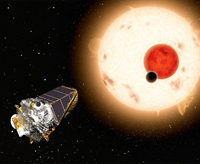HiPACC Computational Astronomy Press Room. From: AMES
The Press Room highlights computational astronomy work around the UC-HiPACC consortium; the wording of the short summaries on this page is based on wording in the individual releases or on the summaries on the press release page of the original source. Press releases below appear in reverse chronological order (most recent first); they can also be displayed by UC campus or DOE lab by clicking on the desired venue at the bottom of the left-hand column.
October 17, 2014 — NASA supercomputers support IRIS discovery in the Sun’s ‘region of mystery’
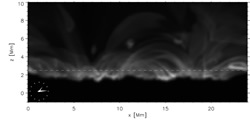
Synthetic image calculated from one of the numerical simulations produced with the BIFROST code (developed at the University of Oslo, Norway) and run on NASA’s Pleiades supercomputer. The image shows plasma at 140,000°F and is full of loops that have properties similar to those observed with IRIS. Credit: Viggo Hansteen, University of Oslo, Norway
NASA Ames 10/17/2014—A team of scientists investigating the mysterious, fog-like transition layer of the Sun are combining observations from NASA’s Interface Region Infrared Spectrograph (IRIS) satellite with running high-resolution simulations on the agency’s Pleiades supercomputer to gain a more complete picture of our nearest star. One of the team's findings confirms the existence of magnetic loops in the Sun's transition region—the area between the 1 million°F corona (outer atmosphere) and the much cooler 20,000°F chromosphere, near the surface. Gigantic magnetic loops that span tens of thousands of miles had often been seen in the Sun’s corona, but not in the transition region. They had also been seen in movies generated from numerical models run on NASA’s Pleiades supercomputer (currently the ninth fastest system in the U.S), but the scientists thought they were a fluke—some flaw in the model. But within a few days after opening the telescope aboard IRIS in July 2013, they “saw tiny little loops popping up all over the place.” Details of the IRIS science team’s discoveries are reported in a special section of the 17 October issue of
Science.

View AMES Press Release
April 4, 2014 — Heliophysics modeling and simulation website debuts
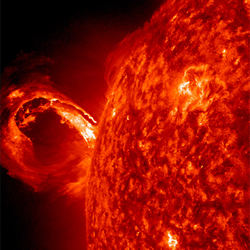
Coronal mass ejection observed by NASA’s Solar Dynamics Observatory, in extreme ultraviolet radiation emitted by ionized helium atoms heated to 80,000 Kelvin. The eruption is caused by a magnetic field that was generated by a dynamo process beneath the physical surface of the sun. (NASA/SDO)
NASA Ames 4/4/14 —The science community has long understood that solar activity is caused by magnetic fields generated deep inside the Sun. Solar variability is a leading factor in determining space weather, which has a great impact on Earth’s environment and modern human activities (including electronics and telecommunications). The Heliophysics Modeling and Simulation (HMS) project team is developing high-fidelity modeling and simulation tools that enable research on the interiors and atmospheres of the Sun and other stars. The HMS project supports NASA’s Living With a Star Program goal to provide a predictive understanding of the Sun’s system, specifically of the space weather conditions near Earth and in the interplanetary medium.
View AMES Press Release
21 February 2014 — NASA's IRIS Spots Its Largest Solar Flare
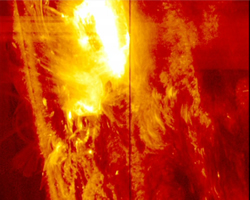
On Jan. 28, 2014, NASA's newly-launched Interface Region Imaging Spectrograph, or IRIS, observed its strongest solar flare to date.
NASA Ames 2/21/14 — On Jan. 28, 2014, NASA's Interface Region Imaging Spectrograph (IRIS) mission, which utilizes the Pleiades supercomputer to carry out numerical simulations, witnessed an M–class solar flare in late January, the largest flare the spacecraft viewed since its launch June 2013.
Read full NASA Ames press release. Includes video.
January 6, 2014 — Galaxy teems with sub-Neptune planets that are missing in our own solar system
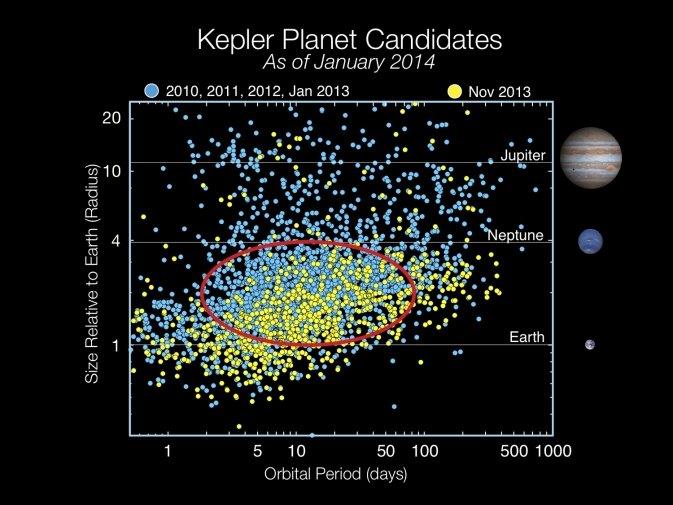
More than three-quarters of the planet candidates discovered by NASA's Kepler spacecraft have sizes ranging from that of Earth to that of Neptune, which is nearly four times as big as Earth. Such planets dominate the galactic census but are not represented in our own solar system. (Image: NASA Ames)
NASA Ames and UC Berkeley — UC Berkeley astronomer Geoff Marcy led a large team of Kepler space telescope scientists in analyzing high-precision Doppler data on newly discovered exoplanets, three-quarters of which are in a size range — larger than Earth but smaller than Neptune — that are common in our galaxy but mysteriously missing in our solar system.
View full NASA Ames press release
September 19, 2013 — NASA's Pleiades Supercomputer Upgraded, Harpertown Nodes Repurposed
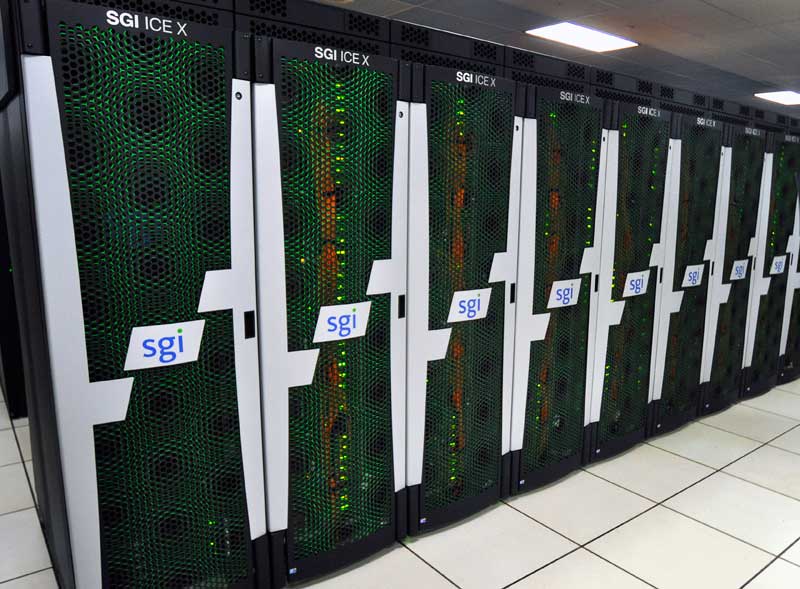
The Pleiades supercomputer was augmented with 46 SGI ICE X racks containing Intel Xeon E5-2680V2 (Ivy Bridge) processors, and runs at a theoretical peak of approximately 2.87 petaflops.
NASA Ames - System engineers in the NASA Advanced Supercomputing (NAS) Division have upgraded the Pleiades supercomputer and repurposed its original hardware to help meet NASA's ever-increasing requirements for high-performance computing cycles. The newly configured system is capable of 61 teraflops (trillion floating-point operations per second) of peak performance.
view full NASA Ames Press Release
September 18, 2013 — What’s next for NASA’s Kepler planet hunter
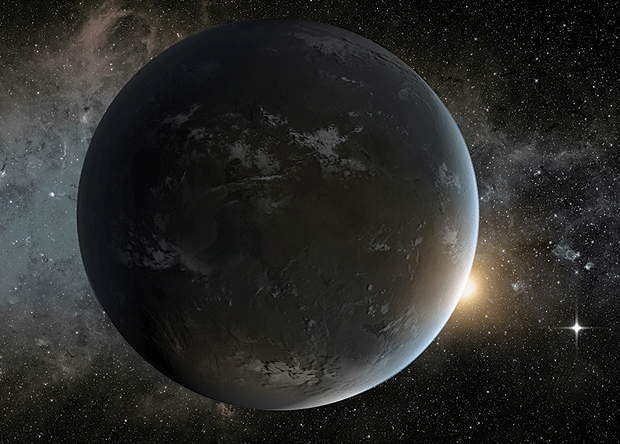
An artist’s rendition shows Kepler-62f, a “super-Earth” in the habitable zone of a star 1200 light-years from Earth.
NASA’s exoplanet-hunting spacecraft may be permanently disabled by two broken gyroscope wheels, but researchers say the best results are yet to come. Using the processing power of the Pleiades supercomputer at NASA Ames, Kepler researchers are exploring new ways to analyze four years of data that Kepler has collected since its launch in 2009. That analysis effort, which will incorporate new machine-learning techniques and a bit of human experimentation, could yield a bounty of new potential planets on top of the 3,500 that Kepler has found so far.
view full NASA Ames Press Release
September 6, 2013 — Introducing NASA’s new quantum computing website

Support structure for installation of the D-Wave Vesuvius processor, which is cooled to 20 millikelvin (near absolute zero).
NASA's Quantum Artificial Intelligence Laboratory (QuAIL) is the space agency's hub for an experiment to assess the potential of quantum computers to perform calculations that are difficult or impossible using conventional supercomputers. NASA’s QuAIL team aims to demonstrate that quantum computing and quantum algorithms may someday dramatically improve the agency’s ability to solve difficult optimization problems for missions in aeronautics, Earth and space sciences, and space exploration. A new website for QuAIL provides an overview of the space agency’s vision for using quantum computing technologies, introduces the research team and their projects, and gives some information on the quantum computer housed in the NASA Advanced Supercomputing facility.
view full NASA Ames Press Release
August 26, 2013 — NASA visualizations hit the Hyperwall
Researchers at the NASA Advanced Supercomputing Division have a lot of processing power at their disposal, particularly with Pleiades: the space agency's most powerful supercomputer, the 9th fastest supercomputer in the United States, and 19th in the world. But when they need to explore data in different ways, they turn to hyperwall-2, a powerful collection of 128 LCD monitors that can show complex physical events in very high resolution. The visualizations that run on hyperwall-2 are critical to furthering NASA's scientific understanding of the universe. Powered by over 1,000 AMD Opteron cores and 128 NVIDIA GeFore GPUs, the hyperwall-2’s system is directly connected to the Pleiades supercomputer's filesystem and can display, process, and share data among each of the 128 screens, allowing endless configurations for analyzing data.
view full HPC Wire Press Release
July 29, 2013 — IRIS Mission Gets First Look at Sun's Mysterious Interface Region
NASA's Interface Region Imaging Spectrograph (IRIS) spacecraft has captured its first observations of the lowest layers of the Sun’s atmosphere in unprecedented detail. In combination with 3-D numerical simulations run on NASA's Pleiades supercomputer, IRIS will provide new insights into the dynamic magnetic structures and material flows within our sun.
view full NASA Ames Press Release
May 14, 2013 — Optimized BLENDER Code Speeds Up Kepler Planet Analyses
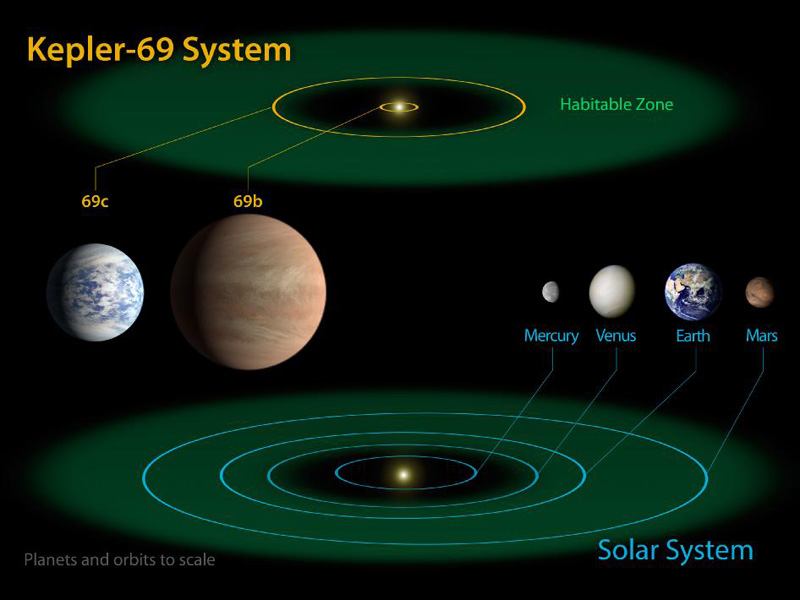
This diagram compares the planets of the inner Solar System to Kepler-69, a two-planet system about 2,700 light-years from Earth in the constellation Cygnus. The two planets of Kepler-69 orbit a star that belongs to the same class as our Sun. NASA Ames, JPL-Caltech
NASA Ames, May 14, 2013 - Visualization experts in the NASA Advanced Supercomputing (NAS) Division have improved the BLENDER software package used by the Kepler mission team to validate planet candidates, greatly shortening runtimes on the Pleiades supercomputer.
view full NASA Ames Press Release
October 23, 2012 — NASA - Computer Model Shows a Disk Galaxy's Life History
A cosmological simulation run on the Pleiades supercomputer (using more than a million CPU hours) shows the development of a disk galaxy over 13.5 billion years from shortly after the Big Bang to the present.
view LANL abstract
September 27, 2012 — Simulations Uncover 'Flashy' Secrets of Merging Black Holes
According to Einstein, whenever massive objects interact, they produce gravitational waves -- distortions in the very fabric of space and time -- that ripple outward across the universe at the speed of light. While astronomers have found indirect evidence of these disturbances, the waves have so far eluded direct detection. Ground-based observatories designed to find them are on the verge of achieving greater sensitivities, and many scientists think that this discovery is just a few years away.
Catching gravitational waves from some of the strongest sources -- colliding black holes with millions of times the sun's mass -- will take a little longer. These waves undulate so slowly that they won't be detectable by ground-based facilities. Instead, scientists will need much larger space-based instruments, such as the proposed Laser Interferometer Space Antenna, which was endorsed as a high-priority future project by the astronomical community.
A team that includes astrophysicists at NASA's Goddard Space Flight Center in Greenbelt, Md., is looking forward to that day by using computational models to explore the mergers of supersized black holes. Their most recent work investigates what kind of "flash" might be seen by telescopes when astronomers ultimately find gravitational signals from such an event. ..
view full NASA Ames Press Release
April 25, 2012 — “NASA Scientists Find History of Asteroid Impacts in Earth Rocks"
Research by NASA and international scientists concludes giant asteroids, similar or larger than the one believed to have killed the dinosaurs, hit Earth billions of years ago with more frequency than previously thought. Computer models of the ancient main asteroid belt ran at the NASA Advanced Supercomputing (NAS) Division.
view NASA Ames Press Release
April 2, 2012 — Simulating the stars
NAS visualization and data analysis expert Chris Henze, with Kepler mission engineer Todd Klaus, explain their techniques for processing 'astronomical' amounts of star data on the Pleiades supercomputer.
view article
March 6, 2012 — Searching for Sister Planets
The discovery that planets orbit the Sun in ellipses, rather than circles, was made by 16th century mathematician and astronomer Johannes Kepler using only the observations of his predecessors and his own unique calculations—without the aid of the yet-to-be invented telescope and long before modern computers were dreamed of.
Today, with the help of one of NASA's largest space telescopes and its most powerful supercomputer, scientists are analyzing observational data gathered from that pioneering astronomer's modern-day namesake—the Kepler mission spacecraft—to search the skies for Earth's sister planets and make new astronomical discoveries.
View NASA AMES Press Release









